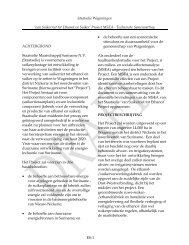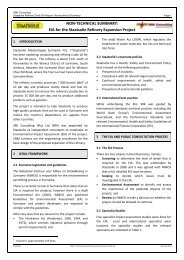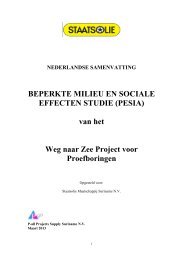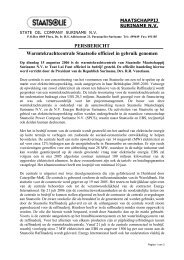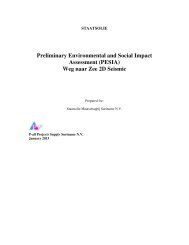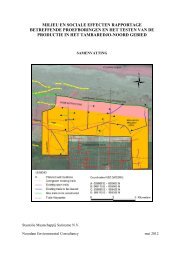concept EIA-rapport - Staatsolie
concept EIA-rapport - Staatsolie
concept EIA-rapport - Staatsolie
Create successful ePaper yourself
Turn your PDF publications into a flip-book with our unique Google optimized e-Paper software.
SRK Consulting: Project No: 439414 <strong>Staatsolie</strong> Pipeline <strong>EIA</strong> – Draft <strong>EIA</strong> Report Page 57<br />
The overall significance of impacts was determined by considering consequence and probability<br />
using the rating system prescribed in Table 6-5 below.<br />
Table 6-5: Impact significance ratings<br />
Consequence<br />
Probability<br />
Improbable Possible Probable Definite<br />
Very Low INSIGNIFICANT INSIGNIFICANT VERY LOW VERY LOW<br />
Low VERY LOW VERY LOW LOW LOW<br />
Medium LOW LOW MEDIUM MEDIUM<br />
High MEDIUM MEDIUM HIGH HIGH<br />
Very High HIGH HIGH VERY HIGH VERY HIGH<br />
Finally the impacts were also considered in terms of their status (positive or negative impact) and the<br />
confidence in the ascribed impact significance rating. The prescribed system for considering impacts<br />
status and confidence (in assessment) is laid out in Table 6-6 below.<br />
Table 6-6: Impact status and confidence classification<br />
Status of impact<br />
Indication whether the impact is adverse (negative) or<br />
beneficial (positive).<br />
Confidence of assessment<br />
The degree of confidence in predictions based on<br />
available information, SRK’s judgment and/or specialist<br />
knowledge.<br />
+ ve (positive – a ‘benefit’)<br />
– ve (negative – a ‘cost’)<br />
REUT/DALC 439414_<strong>Staatsolie</strong>Pipeline<strong>EIA</strong>_Draft <strong>EIA</strong> Report_Final June 2012<br />
Low<br />
Medium<br />
Different types of impacts will also be considered in the impact ratings, as listed in Box 6-2 below.<br />
Box 6-2: Types of impact<br />
Direct – impacts that result from the direct interaction between a project activity and the receiving<br />
High<br />
environment (e.g. dust generation which affects air quality).<br />
Indirect – impacts that result from other (non-project) activities but which are facilitated as a result<br />
of the project (e.g. in-migration of job-seekers, which places additional demands on natural<br />
resources) or impacts that occur as a result of subsequent interaction of direct project impacts within<br />
the environment (e.g. reduced air quality that affects crop production and subsequently impacts on<br />
subsistence-based livelihoods).<br />
Cumulative – impacts that act together with current or future potential impacts of other activities or<br />
proposed activities in the area/region that affect the same resources and/or receptors (e.g.<br />
combined effects of waste water discharges from more than one project into the same water<br />
resource, which may be acceptable individually, but cumulatively result in a reduction in water<br />
quality and fishing productivity).<br />
There is no statutory definition of ‘significance’ and its determination is therefore necessarily partially<br />
subjective. Criteria for assessing the significance of impacts arise from the following key elements:<br />
• Status of compliance with relevant Suriname legislation, policies and plans, any relevant or<br />
industry policies, environmental standards or guidelines and internationally accepted best<br />
practice;<br />
• The consequence of the change to the biophysical or socio-economic environment (e.g. loss of<br />
habitats, decrease in water quality) expressed, wherever practicable, in quantitative terms. For<br />
socio-economic impacts, the consequence should be viewed from the perspective of those






